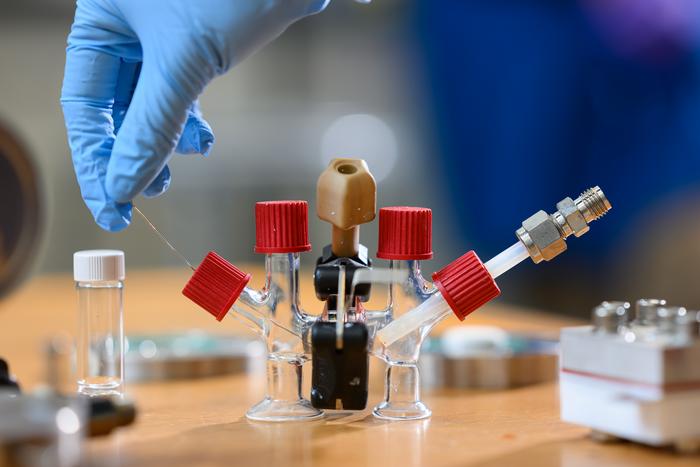
In the relentless quest for cleaner, more efficient energy storage, an extraordinary breakthrough has emerged from the laboratories of the Massachusetts Institute of Technology that promises to revolutionize electric transportation. Departing from the constraints of conventional lithium-ion batteries, researchers have unveiled a novel sodium-air fuel cell technology that offers staggering improvements in energy density, cost-effectiveness, and environmental sustainability. Unlike traditional batteries, which store energy in a fixed chemical form, this innovative fuel cell leverages liquid sodium metal as a fuel source and ambient air as its oxidizer, enabling rapid refueling and unprecedented energy storage capabilities, potentially catalyzing the electrification of aircraft, marine vessels, and trains.
Conventional lithium-ion batteries, which dominate electric vehicles today, are nearing theoretical limits for power-to-weight efficiency, creating a bottleneck particularly detrimental for weight-sensitive applications like aviation. The newly developed sodium-air fuel cell addresses these challenges by substituting the lithium-ion architecture with a system where sodium metal — a plentiful and inexpensive material — undergoes a controlled electrochemical reaction with oxygen from air. A ceramic electrolyte layer strategically positioned between the sodium and air electrodes permits sodium ions to migrate freely while preventing direct mixing of reactants, ensuring efficient and safe operation of the cell.
At the heart of this technology lies a carefully engineered interface: a porous cathode facing the air side facilitates the crucial chemical reaction between sodium ions and oxygen, producing electrical energy and chemical byproducts. This configuration contrasts with traditional batteries by functioning as a fuel cell rather than a sealed energy container — meaning the sodium fuel can be replenished swiftly, sidestepping the long recharge durations characteristic of lithium-ion alternatives. Such a design paradigm could herald a new era of electric propulsion with a striking threefold increase in gravimetric energy density over state-of-the-art lithium-ion batteries.
The prototype devices demonstrated by the MIT team employ two main architectural designs. The first, an H-cell configuration, integrates two glass tubes connected by a central tube filled with a ceramic electrolyte and an air electrode—liquid sodium fills one tube, while oxygen-rich air passes through the other. The second design is horizontal, with a tray holding the electrolyte and sodium, and the air electrode situated beneath. Both configurations have been rigorously tested under precisely controlled humidity conditions, yielding energy densities on the order of 1,700 watt-hours per kilogram at the single-cell level, with over 1,000 watt-hours per kilogram projected at the system scale after full integration.
One of the most transformative aspects of this sodium-air fuel cell is its potential to meet pivotal energy density thresholds necessary for practical electric aviation. Current lithium-ion batteries, with their approximate 300 watt-hours per kilogram ceiling, fall significantly short of the 1,000 watt-hours per kilogram benchmark widely regarded as essential for electric regional flights — which constitute roughly 80 percent of domestic air travel and account for nearly one-third of aviation emissions. By surpassing this threshold, sodium-air fuel cells could propel the electrification of commuter aircraft, substantially reducing aviation’s carbon footprint.
Beyond aviation, this technology bears implications for the electrification of marine and rail systems, sectors similarly demanding in terms of energy density and cost constraints. Sodium’s wide availability — sourced primarily from abundant sodium chloride deposits worldwide — ensures a supply chain less vulnerable to geopolitical or extraction difficulties that plague lithium-dependent technologies. Furthermore, historical industrial precedents, such as the extensive sodium metal production during the era of leaded gasoline additives, underscore the feasibility of scaling this material’s manufacturing to support broad electric power applications.
Safety considerations have guided the design and materials selection rigorously. Sodium metal’s reactive nature necessitates containment within robust, sealed cartridges. However, unlike battery chemistries storing both reactants in close proximity — which can induce hazardous runaway reactions upon breach — the fuel cell’s separation of concentrated sodium from more dilute ambient air markedly reduces safety risks. The design thus combines high energy density with an intrinsic safety advantage, offering a compelling alternative to both lithium-ion and other metal-air battery systems.
A remarkable environmental benefit stems from the unique chemical byproducts of the sodium-air reaction. Instead of emitting greenhouse gases during operation as fossil fuel engines do, the cell produces sodium oxide, which subsequently reacts with atmospheric moisture and carbon dioxide to form sodium bicarbonate — common baking soda. This cascade effectively captures carbon dioxide, potentially producing a net-zero or even carbon-negative emission profile during flight. If the sodium bicarbonate deposits reach marine environments, they could contribute to mitigating ocean acidification, another global environmental concern linked to elevated atmospheric CO₂ levels.
This natural chemical cascade not only enhances environmental sustainability but also offers economic advantages by generating a valuable byproduct essentially for free, bypassing the prohibitive costs historically associated with sodium hydroxide-based carbon capture methods. The researchers emphasize that this synergy between energy storage and carbon sequestration embodies a paradigm shift in how we conceive clean energy systems and their ecological footprints.
The sodium-air fuel cell prototype is still emerging from its lab-scale incarnation, with the research team aiming to commercialize the technology within the coming years. A startup company, Propel Aero, headquartered within MIT’s innovation incubator The Engine, is advancing efforts to scale up the technology from single-cell demonstrations to fully functional fuel packs suitable for aviation applications. Initial milestones include constructing fuel cell bricks roughly the size of a large book capable of delivering around 1,000 watt-hours, sufficient to power sizeable drones and prove the system’s viability in real-world scenarios such as precision agriculture.
The team’s discovery that ambient humidity plays a pivotal role in the electrochemical processes was central to achieving their performance breakthroughs. With dry oxygen, unwanted solid discharge products impair performance by clogging electrode pores. Introducing controlled humidity results in liquid-phase discharge products that evacuate more efficiently, maintaining electrode activity and prolonging operational life. This insight represents a sophisticated interplay between material science, electrochemistry, and system design fundamentals, showcasing the multidisciplinary nature of modern energy research.
Engineering this system demanded a fusion of diverse scientific disciplines. Drawing upon decades of knowledge from metal-air battery studies, fuel cell engineering, and high-temperature electrochemistry, the team synergized these domains with novel innovations in humidity control and electrode architecture. The outcome is a scalable, efficient fuel cell that could redefine energy storage paradigms with profound implications for environmental sustainability and transportation technology.
The collaborative research benefited from contributions by numerous scientists and engineers, including graduate students, industry partners from companies such as Form Energy and And Battery Aero, and academic collaborators. Support from visionary funding agencies including ARPA-E, Breakthrough Energy Ventures, and the National Science Foundation has enabled the sustained progress necessary for such a potentially disruptive technological advance. Additionally, MIT.nano facilities provided the advanced instrumentation essential for materials characterization and performance validation.
As global net-zero targets intensify the pressure to transition transportation towards sustainable energy sources, innovations like the sodium-air fuel cell epitomize the blend of scientific ingenuity and practical engineering required to overcome entrenched technological barriers. By offering a pathway to low-cost, high-density, and carbon-neutral electric power, this emerging technology could play a critical role in a cleaner, more resilient future of mobility across the skies, seas, and land.
Subject of Research: Sodium-Air Fuel Cell Technology for High Energy Density and Sustainable Electric Power
Article Title: Sodium-Air Fuel Cell for High Energy Density and Low-Cost Electric Power
News Publication Date: 27-May-2025
Web References:
DOI: 10.1016/j.joule.2025.101962
MIT’s The Engine Incubator
Image Credits: Credit: Gretchen Ertl, Massachusetts Institute of Technology
Keywords
Energy, Batteries, Electrochemistry, Fuel cells, Sustainability, Engineering, Transportation engineering, Aviation, Vehicles, Aircraft, Automobiles, Electric vehicles, Materials science, Physics
Tags: advantages of sodium over lithium in batterieschallenges in conventional battery technologiesefficient energy density in fuel cellselectric aviation advancementselectrification of marine and train transportenvironmental impact of new fuel sourcefuture of clean energy in aviationMIT breakthrough in energy technologyrapid refueling capabilities for electric vehiclesrenewable energy storage solutionssodium-air fuel cell technologysustainable transportation innovations


